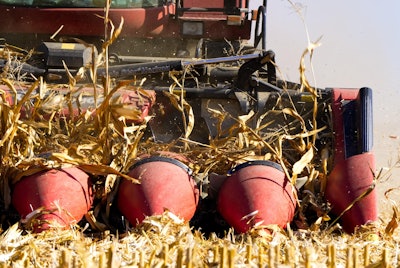
Challenges facing the commercial grain handling industry are mounting this fall as record crop production meets continued trade uncertainty, creating a battle for bunker space across the United States.
During a CoBank, Knowledge Exchange webinar, Tanner Ehmke, lead economist, grains and oilseeds, CoBank, highlighted the implications of abundant supply hitting markets already weakened by stalled trade negotiations, particularly with China.
“This is a lot of corn we’re going to be dealing with,” Ehmke said. “We’re already talking about the implications of what this means for this fall. … We're going to have a lot of corn piled on the ground.”
Massive harvest and storage decisions loom
This storage crisis would become reality with a historic corn crop in 2025. USDA projects a trend-line yield of 181 bushels per acre — numbers derived from statistical analysis. Ehmke said with crop conditions “being phenomenally positive” across the US, yields could reach 183-185 bushels per acre or higher on expanded acreage.
USDA’s August crop report, containing the first estimate based on surveys of farmers and fields, will further indicate what’s to come.
“If we had conceivably a national yield of over 186 bushels per acre, that is a 3% increase over USDA trend line estimate,” Ehmke said. “That would be like adding another Wisconsin to the US corn belt, and nearly 500 million bushels added to the crop.”
The market is already pricing in the massive harvest, with September-December corn futures spreads widening significantly as traders anticipate storage premiums.
For grain elevators managing multiple commodities, the fall will bring difficult decisions about storage allocation. With handsome carry premiums across wheat classes and massive corn and soybean crops arriving simultaneously, facilities will face unprecedented competition for space.
“If you are in an area that has wheat and corn and soybeans and grain sorghum, this is going to be a very interesting dynamic,” Ehmke said. “It will be a fight for storage.”
China trade situation
The absence of Chinese demand for new crops is perhaps more concerning for grain exporters. China, which typically purchases about 20% of all US soybeans, has no bushels of new crop on the books.
“We are getting a little concerned here about the lack of Chinese demand,” Ehmke said. “As it is right now, we still do not have a trade deal with China. We have not one bushel of new crop soybeans on the books for China and it’s getting a little late in the year.”
Instead, China has had a record lineup of ships out of Brazil, buying as many as soybeans as they can. Ehmke noted that at some point, Brazilian stocks will be depleted, forcing China to come to the United States for soybeans — trade deal or no trade deal. But it may not happen soon enough.
“We would like these sales to be on the books ahead of harvest, because our shipping pace in Q4 sets the trading pace for the rest of the year ahead,” Ehmke said. “Otherwise, we will have to carry more soybeans into the new year past January 1.”
Weak Chinese demand spells bad news for grain sorghum, as well, with China typically buying 90% of US exports. USDA is forecasting a larger carryover on sorghum stocks, and domestic ethanol cannot fully replace the lost market from Chinese exports.
“I cannot stress enough that we need a trade deal with China sooner rather than later, before we head into the cheap export season of October, November, December,” Ehmke said.
Urgency remains as trade talks progress
The White House reminded all US trading partners in a letter earlier this summer that if they don’t have a trade deal with the United States by August 1, the administration would impose tariffs. Negotiations between US and Chinese officials came as the August 1 deadline loomed large over grain markets. Over meetings in Stockholm, officials agreed to seek an extension of the US-China 90-day tariff truce.
While no major breakthroughs were announced, US Treasury Secretary Scott Bessent and other officials indicated progress was being made. Bessent said that ultimately President Trump would have the final say on extending the trade truce beyond its August 12 expiration date.
Even with talks progressing, the lack of concrete agricultural commitments means grain handlers still face uncertainty heading into the critical fall export season. The timing for resolving trade disputes, particularly with China, is critical before the October-December export season that sets the pace for the marketing year.
The Stockholm talks suggest movement toward resolution, but with Chinese soybean purchases still absent from the books and grain sorghum markets struggling without their primary buyer, the grain handling industry continues to operate under significant uncertainty.
Meanwhile, Ehmke said competitors are gaining ground as Argentina cuts export taxes, Russia slashes interest rates to weaken the ruble, and other exporters become more aggressive with policy tools.
Market implications
The combination of record supplies and trade uncertainty is already pressuring prices. Corn futures have declined to sub-$4 levels that Ehmke characterized as unprofitable for most producers, forcing farmers to rely on record yields to maintain margins.
For grain handlers, the situation presents both challenges and opportunities. While storage capacity will be strained and marketing decisions complicated, the sheer volume of grain moving through the system could support margins for those able to effectively manage the logistics.
“This is a good problem to have,” Ehmke said, particularly for elevators in wheat-growing regions that have struggled with production shortfalls in recent years.
“Now you have the choice of several crops to choose from on what you're going to do with your storage," he said.
The coming months will test the industry's ability to handle what could be one of the largest grain harvests in US history while navigating continued uncertainty in key export markets.

















